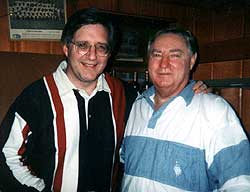 |
|
Dawson City Seven Killing Frank McGee
|
BOOK RELEASE Dawson City Seven "'The match of the century!' Joe Boyle yelled amidst the morning crowd. 'Dawson's here for the grandest Stanley Cup match of them all!'" On December 19, 1904 the Dawson City Nuggets began their 4,000-mile trek to wrest the Stanley Cup from the Ottawa Silver Seven. Twenty-five days later, the rubber-legged, travel-worn players staggered into Ottawa's Union Station - they had trudged 350 miles behind their dog teams, jolted over the narrow-guage White Pass Railway, lurched and rolled aboard the SS Romano, and whiled away endless days on the CPR. The very next evening, theStanley Cup series began. The feisty Nuggets lost their first game 9-2, but they believed they cold win the second game and then the third, and take the Cup home to Dawson City forever. In victory, they would rechristen themselves the "Dawson City Seven." The bare outline of this amazing story is well known, but its wondrous details have never before been told. Now, in Dawson City Seven, Don Reddick brings to life the saga of the most adventurous hockey team that efver took the ice. Dawson City Seven is the ideal historical novel: faithful to fact and human nature at the same time. Reddick weaves into the historical facts the fictional story of Boston Mason, the son of a Confederate soldier who travels from his Massachusetts farm to seek his fortune in the Klondike. Mason's skating prowess earns him a berth as a spare on the Nuggets, a berth to which, Reddick feels, Mason has as much right as anyone - at least as one of the spares on the team that went to Ottawa was a ringer. Don Reddick is a devoted hockey fan, a historian, and a field service engineer. His way with words makes Dawson City Seven spellbinding to history fans and fiction lovers alike.
NUGGETS FROM A YEAR IN SPORTS by Trent Frayne, Maclean's Magazine 1/10/94 "For 90 years, Canadian sports scribes and even learned historians have snoozed over the weirdest and, in some ways, most wonderful chapter in the long story of the Stanley Cup. Nearly a century late, here comes an American field-service engineer showing us our folly."
[Complete review]
"...Don Reddick has written a novel called Dawson City Seven...it's a great story." - Arthur Black, Basic Black radio show
REDDICK DISPLAYS STORY-TELLING PROWESS By Ken Bolton, The Yukon News, 11/5/93 "What makes it such a pleasant read is the skill with which Reddick weaves his tale, and the gentle romanticism with which he imbues the central character."
[Complete review]
"...I loved it." - the Honorable Audrey McLaughlin
CANADIAN BOOK REVIEW ANNUAL by Matt Hartman, 1994 "Reddick has produced a memorable book, one that includes a valuable chunk of Canadian hockey history."
[Complete review]
by Don Morrow, University of Western Ontario "For me, this was an enjoyable book, one unencumbered by anything
smacking of academic standard. [...] I did sense the vastness and the
greatness of the Canadian west, the end of the gold rush era and its
remains as well as the colourfulness and early significance of hockey
before it became so commercialized."
[Complete review]
"...I think this is perhaps the best historical novel I've ever read." - Paul Kitchen, President, Society for International Hockey Research
Letter from Margot Sullivan Dear Don, I would say that your first United States speaking engagement was a smashing success!! Everyone just loved the presentation. Many people were not hockey fans but found the whole story fascinating. The writers in the group loved to hear what you said about how ou found your ideas, publishing experiences, and all the little anecdotes involved in your travels, writing, research, and TV appearances. The video was a perfect lead into talking about DAWSON CITY SEVEN. Anyway the whole evening was JUST RIGHT - different from all the previous authors, multimedia, and in many respects one of the most successful because many in the audience could identify with you. None of the previous authors have provided (thanks Terry) such delicious food and the staff was very spoiled the next day with all of the goodies. I wish we could have let people linger a little longer but since it was the reading room rearranging of furniture had to take place. By the way I thought that room was perfect for a group that size and lent itself easily to a speaker. Again many, many thanks to ou and your whole family. It all went very well. The video is being processed for our collection. Great job! I wish you success upon the United States release and with your next publication. |



